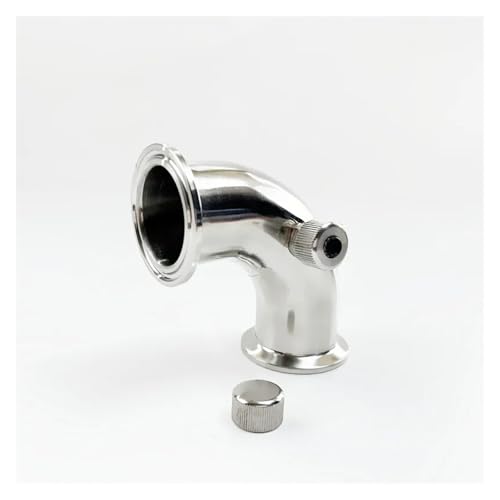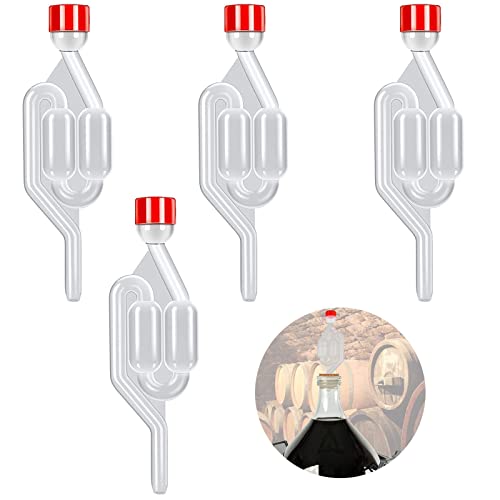You are using an out of date browser. It may not display this or other websites correctly.
You should upgrade or use an alternative browser.
You should upgrade or use an alternative browser.
lager kit on 18 hours and no action , what to do ?
- Thread starter Toastie
- Start date

Help Support The Homebrew Forum:
This site may earn a commission from merchant affiliate
links, including eBay, Amazon, and others.
calumscott
Regular.
- Joined
- Sep 12, 2011
- Messages
- 311
- Reaction score
- 32
18 hours is nothing really...
give it another day before worrying.
give it another day before worrying.
calumscott
Regular.
- Joined
- Sep 12, 2011
- Messages
- 311
- Reaction score
- 32
The thing with brewing is that you are at the mercy of a colony of little organisms... think of it this way:
You create a brand new 23 litre ecosystem with (hopefully, if you've got your sanitation right!) no inhabitants whatsoever and a LOT of food.
You introduce a miniscule number of inhabitants (your little 3g packet of yeast). Now, I'm not entirely sure of the biology of dried yeast but I would imagine to ensure it has a good shelf life it will actually not be dried yeast cells but "spores" - basically radically "cut down" cells where all the cytoplasm (the sort of gooey stuff that fills them out and spaces out all the important bits) is reduced to a minimum. Those spores have to firstly activate and grow themselves into full yeast cells, then start to multiply...
Wiki is suggesting that they double in 1.25 - 2 hours @ 30 degrees (not optimum for brewing but is for scientists). Our 20ish degrees will slow that down, lets say 3 hours.
18 hours is therefore only 6 doubling cycles. 1->2->4->8->16->32->64 times the number you started with. Not a lot really... another 24 hrs...
64->128->256->512->1024->2048->4096->8192->16386 times the number you started with. Now we're talking!!! :party:
This is also why, in some circumstances (my brewing is still lagging behind my biology and maths here so someone else will tell us why...) it is best to make a starter colony first and chuck that in. If you start doubling in your wort from 16386 times the number of viable cells in the packet then you are going to start fizzing pretty quick!!!
The other way to think about it is to imagine the tiny little packet that comes with your kit, then imagine how many times bigger the pack of sludge at the bottom of your FV is after fermentation is complete!!!
All of which is just the biological and mathematical reasoning behind the fundamental rule of brewing...
...have patience and you will be rewarded with good beer! :
You create a brand new 23 litre ecosystem with (hopefully, if you've got your sanitation right!) no inhabitants whatsoever and a LOT of food.
You introduce a miniscule number of inhabitants (your little 3g packet of yeast). Now, I'm not entirely sure of the biology of dried yeast but I would imagine to ensure it has a good shelf life it will actually not be dried yeast cells but "spores" - basically radically "cut down" cells where all the cytoplasm (the sort of gooey stuff that fills them out and spaces out all the important bits) is reduced to a minimum. Those spores have to firstly activate and grow themselves into full yeast cells, then start to multiply...
Wiki is suggesting that they double in 1.25 - 2 hours @ 30 degrees (not optimum for brewing but is for scientists). Our 20ish degrees will slow that down, lets say 3 hours.
18 hours is therefore only 6 doubling cycles. 1->2->4->8->16->32->64 times the number you started with. Not a lot really... another 24 hrs...
64->128->256->512->1024->2048->4096->8192->16386 times the number you started with. Now we're talking!!! :party:
This is also why, in some circumstances (my brewing is still lagging behind my biology and maths here so someone else will tell us why...) it is best to make a starter colony first and chuck that in. If you start doubling in your wort from 16386 times the number of viable cells in the packet then you are going to start fizzing pretty quick!!!
The other way to think about it is to imagine the tiny little packet that comes with your kit, then imagine how many times bigger the pack of sludge at the bottom of your FV is after fermentation is complete!!!
All of which is just the biological and mathematical reasoning behind the fundamental rule of brewing...
...have patience and you will be rewarded with good beer! :

johnnyboy1965
Landlord.
calumscott said:The thing with brewing is that you are at the mercy of a colony of little organisms... think of it this way:
You create a brand new 23 litre ecosystem with (hopefully, if you've got your sanitation right!) no inhabitants whatsoever and a LOT of food.
You introduce a miniscule number of inhabitants (your little 3g packet of yeast). Now, I'm not entirely sure of the biology of dried yeast but I would imagine to ensure it has a good shelf life it will actually not be dried yeast cells but "spores" - basically radically "cut down" cells where all the cytoplasm (the sort of gooey stuff that fills them out and spaces out all the important bits) is reduced to a minimum. Those spores have to firstly activate and grow themselves into full yeast cells, then start to multiply...
Wiki is suggesting that they double in 1.25 - 2 hours @ 30 degrees (not optimum for brewing but is for scientists). Our 20ish degrees will slow that down, lets say 3 hours.
18 hours is therefore only 6 doubling cycles. 1->2->4->8->16->32->64 times the number you started with. Not a lot really... another 24 hrs...
64->128->256->512->1024->2048->4096->8192->16386 times the number you started with. Now we're talking!!! :party:
Not 100% correct there...When you add dried yaest to a brew the first thing that happens is that the coating of the dried yeast is broken down releasing the yeast cells inside. The yeast will then consume all the dissolved oxygen in the wort (this is why we ariate at this stage). Once the dissolved oxygen has been depleted it will start to consume to the sugars. There are now two by-products, alcohol (not exactly true) and CO2. Every strain of yeast has a optimum temp to work at its best, as brewers we want that to be as quick as possible, so we ferment at the optimum temp for that strain of yeast. We need to set the correct temps and conditions for the yeast to do its job
This is also why, in some circumstances (my brewing is still lagging behind my biology and maths here so someone else will tell us why...) it is best to make a starter colony first and chuck that in. If you start doubling in your wort from 16386 times the number of viable cells in the packet then you are going to start fizzing pretty quick!!!
The other way to think about it is to imagine the tiny little packet that comes with your kit, then imagine how many times bigger the pack of sludge at the bottom of your FV is after fermentation is complete!!!
All of which is just the biological and mathematical reasoning behind the fundamental rule of brewing...
...have patience and you will be rewarded with good beer! :

£63.25
Sanitary clamp 1.5" (38mm) OD50.5mm Sanitary Tri-Clamp 90-Degree Pipe With Nipple And Electronic Thermometer, Stainless Steel 304 Home brewing(Without Thermometer)
DAN CHENG XIAN PENG SHI DA SHANG MAO DIAN

£11.95
£14.99
FOR THE LOVE OF HOPS (Brewing Elements): The Practical Guide to Aroma, Bitterness and the Culture of Hops
Amazon.co.uk

£32.95
£34.95
DIAH DO IT AT HOME Beer & Wine Making Starter Kit - Basic Equipment - All You Need in One Box Homemade Beer & Wine Home Brewing
do-it-at-home

£14.70 (£148.15 / kg)
Spicy World Tartaric Acid Pure 3.5oz - Top Grade, USP Certified, Food Grade, Vegan - Perfect for Wine Making, Mead
Amazon US

£14.25
£18.99
How to Brew: Everything You Need to Know to Brew Great Beer Every Time
Amazon.co.uk

£13.58
Banziaju Wine Making Supplies, 18" Auto Siphon Hose For Water Homebrew Siphon Pump With Tubing And Clamp Clear Wine Siphon For Beer Wine Making Kit
Jian Shi Xian Chao Mei Shang Mao You Xian Gong Si

£14.76
Digital Temperature Watch Heating Thermometer Home Brewing Tools for Wine Bottle
B&D DIRECT STORE

£437.77
HMCOCOOFM 4L 4" OD119mm * 1.5" OD50.5mm Copper Onion Head For Homebrewing,Thickness 1.5mm (With Thermometer)
weifangguanhuawangluokejiyouxiangongsi

£23.75 (£25.45 / 75 cl)
Kinsale Mead Co. Atlantic Dry Mead 70cl, Light, Off Dry, Refreshingly Different Award-Winning Honey Mead, 12% ABV
Amazon.co.uk

£11.95
£14.99
WATER COMPREHENSIVE GUIDE (Brewing Elements): A Comprehensive Guide for Brewers
Amazon.co.uk

£73.98
Sanitary clamp 2" (51mm) OD64mm Sanitary Tri-Clamp 90-Degree Pipe With Nipple And Electronic Thermometer, Stainless Steel 304 Home brewing(Without Thermometer)
DAN CHENG XIAN PENG SHI DA SHANG MAO DIAN

£63.25
HJBFZZBD Sanitary clamp 1.5" (38mm) FlangeOD50.5mm Sanitary Tri-Clamp 90-Degree Pipe With Middle Nipple And Electronic Thermometer, Stainless Steel 304 Home brewing(Without Thermometer)
DAN CHENG XIAN PENG SHI DA SHANG MAO DIAN

£15.96
£16.99
The Brew Your Own Big Book of Clone Recipes: Featuring 300 Homebrew Recipes from Your Favorite Breweries
Amazon.co.uk
johnnyboy1965
Landlord.
Sorry Ive seemed to have posted my reply halfway between yours...sorry
Toastie
Regular.
- Joined
- Jan 11, 2012
- Messages
- 223
- Reaction score
- 0
rite then , opinion needed .
still no bubbles after 48 hours so i think maybe a leaky bucket , it all looks fine but its hard to say so do a reading and its dropped quit a lot , i wasn't that hight to start at 1036 but after 24 hours is down to 1020 .
so at a guess i would say that's ok ?
cheers for input :) d
still no bubbles after 48 hours so i think maybe a leaky bucket , it all looks fine but its hard to say so do a reading and its dropped quit a lot , i wasn't that hight to start at 1036 but after 24 hours is down to 1020 .
so at a guess i would say that's ok ?
cheers for input :) d
Sounds like everything is fine mate :thumb:
Unless you have a screw top fermenter some gas will probably escape causing the air lock to bubble less frequently, i only use them if brewing wine. Your hydrometer is the best way to check if anything is happening
:
Unless you have a screw top fermenter some gas will probably escape causing the air lock to bubble less frequently, i only use them if brewing wine. Your hydrometer is the best way to check if anything is happening
:

Similar threads
- Replies
- 16
- Views
- 486
- Replies
- 6
- Views
- 620
- Replies
- 0
- Views
- 173














![BREWING THERMOMETER STICKERS ACCURATELY MONITOR FERMENTING BEER & WINE LIQUID TEMPERATURES 5PCS HOME BREW SPIRITS WINE LCD ADHESIVE [US]](https://m.media-amazon.com/images/I/311DDjo2X3L._SL500_.jpg)












